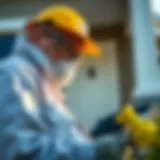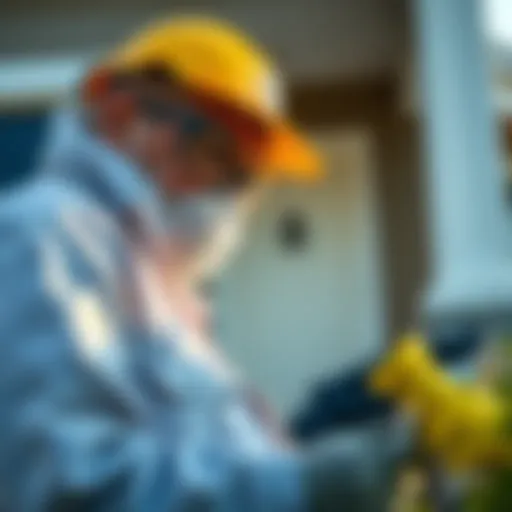Pest Control Solutions in Thornton, Colorado
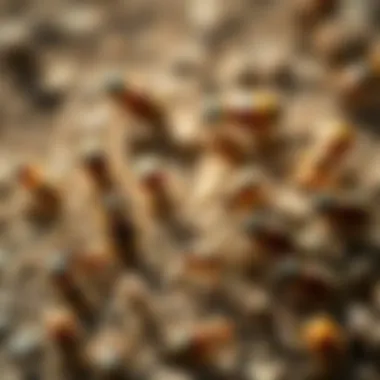
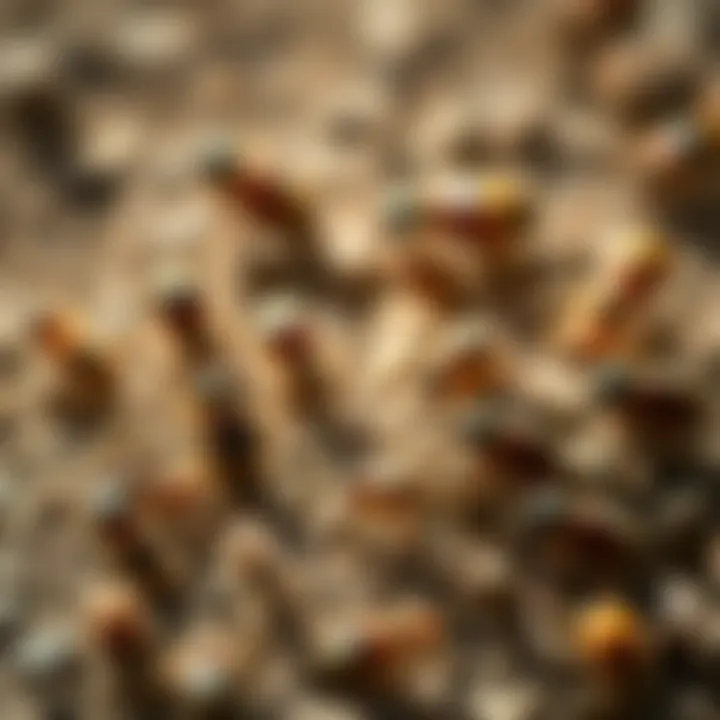
Intro
Pest control isn't just a matter of keeping a home neat and tidy. In Thornton, Colorado, the local ecosystem presents its own unique set of challenges and pest-related issues that residents need to be aware of. Denver's nearby proximity creates an environment ripe for a variety of pests, and understanding how these unwanted visitors can infiltrate homes is fundamental for effective management. This comprehensive guide aims to arm homeowners with the knowledge they need to identify common pests, implement preventive measures, and explore viable control strategies. Whether you’re a new homeowner or someone who’s spent years in the area, the insights provided will help you protect the sanctity of your home while maintaining a commitment to sustainable practices.
Pest Identification
Identifying pests early can mean the difference between a minor annoyance and a full-blown infestation. It is essential to be familiar with the specific pests that can infiltrate homes in Thornton and the signs that indicate their presence.
Common Household Pests
Most homeowners in Thornton might encounter:
- Ants: Often found marching in a line near food sources, these critters come in various species. The most common is the sugar ant, drawn to sweets and moisture.
- Rodents: These include mice and rats, which can squeeze through surprisingly small gaps. Look for droppings or gnaw marks.
- Spiders: While not all spiders are harmful, a black widow can be a serious concern. Spotting one in your living space is a warning sign.
- Termites: Known as “silent destroyers,” they can cause significant damage before being detected. Look for mud tubes or damaged wood.
Understanding these pests and their habits is the first step toward effective management.
Signs of Infestation
Recognizing the signs of infestation can help homeowners tackle pest problems before they escalate. Some common indicators include:
- Droppings: Finding rodent droppings near food packages or in cupboards is a sure sign of a problem.
- Nests: Whether it’s in the attic or under the sink, the presence of nests indicates that pests are making themselves at home.
- Gnaw marks: Inspect wooden surfaces and baseboards for signs of chewing, which indicates the presence of rodents.
- Strange noises: Listen for scratching or scurrying sounds, especially at night, which could indicate that critters are moving around inside walls.
"Early detection is key in preventing a minor nuisance from turning into a significant issue."
Prevention Methods
Keeping pests at bay is always better than dealing with an infestation once it occurs. Practical prevention methods can significantly mitigate the chances of pest-related issues arising.
Environmental Modifications
Modifying the environment around your home is crucial. Some effective strategies include:
- Sealing Cracks: Fill gaps around doors, windows, and foundations to block entry points.
- Remove Standing Water: This eliminates breeding grounds for pests such as mosquitoes.
- Landscaping: Keep plants trimmed and away from the building to reduce pest access.
Home Maintenance Tips
Regular maintenance within the home can go a long way:
- Clean Regularly: Keep floors and surfaces free of crumbs and spills that may attract pests.
- Proper Food Storage: Store food in airtight containers to prevent ant infestations.
- Routine Inspections: Periodically check areas prone to pest activity, including basements and attics.
DIY Pest Control Solutions
For those who prefer to tackle pest issues on their own, several do-it-yourself solutions can be just as effective as professional methods.
Natural Remedies
Many natural solutions can deter or eliminate pests:
- Vinegar: A simple mix of vinegar and water can deter ants and fruit flies.
- Essential Oils: Scents like peppermint oil are known to repel spiders and rodents. Mix with water and spray around entry points.
- Diatomaceous Earth: Sprinkle this natural powder in infested areas. It can kill insects by dehydrating them.
DIY Traps and Barriers
Constructing traps can help manage populations without chemicals:
- Homemade Ant Traps: Mix sugar with borax and place in a container. Ants will take the bait back to the colony.
- Fruit Fly Traps: A simple trap can be made using a bowl of vinegar covered with plastic wrap, pierced with holes.
In sum, effective pest control in Thornton isn't a daunting task. Regular identification, preventative measures, and knowledgeable DIY solutions can make a world of difference in maintaining a pest-free environment.
For further insights on pest control methods and local pest management resources, consider visiting CDC Pest Control or checking community feedback on Reddit.
Understanding Pest Control
Pest control refers to the management of species considered detrimental to human health, agriculture, or the environment. This includes a wide range of organisms from rodents and insects to larger wildlife that might invade residential areas. Understanding pest control is not just about eliminating these pests; it’s about developing strategies to manage their populations effectively while minimizing harm to the ecosystem.
Defining Pest Control
Pest control is a multifaceted approach that integrates various methods to handle pest populations. Often, people think of it solely in terms of chemicals and toxins, but it encompasses much more. Pest control involves:
- Preventative measures: This can include structural repairs, sealing entry points, and habitat management to reduce pest attraction.
- Monitoring and identification: Recognizing the type of pest, its lifecycle, and behavior is crucial to determining the best control method.
- Management strategies: These might range from chemical applications to non-chemical or preventive measures that focus on disruption of pest life cycles.
At its core, understanding pest control means recognizing the balance between human needs and the natural environment. This delicate balance is especially relevant in urban settings where pest pressures can amplify.
Importance in Urban Areas
Urban areas like Thornton face unique pest control challenges due to high human densities, mixed land use, and varying waste management practices. As neighborhoods develop and expand, they can inadvertently create ideal conditions for many pests. The importance of efficient pest control in urban locales includes:
- Health and Safety: Pests like mice, rats, and certain insects can pose significant health risks. They can transmit diseases, contaminate food, and create allergy issues. Thus, effective pest control protects the community’s well-being.
- Property Protection: Termites and other wood-destroying insects can lead to costly damage. Early identification and management are essential to preserving properties in densely populated areas.
- Aesthetic Appeal: Pests can diminish the visual appeal of neighborhoods by ruining gardens and public spaces. Keeping these areas pest-free not only enhances property values but also community pride.
"An ounce of prevention is worth a pound of cure" – This saying is especially true in pest control. Addressing potential pest issues before they become major problems can save homeowners a great deal of time, money, and stress.
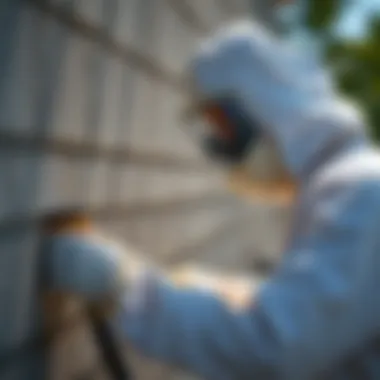
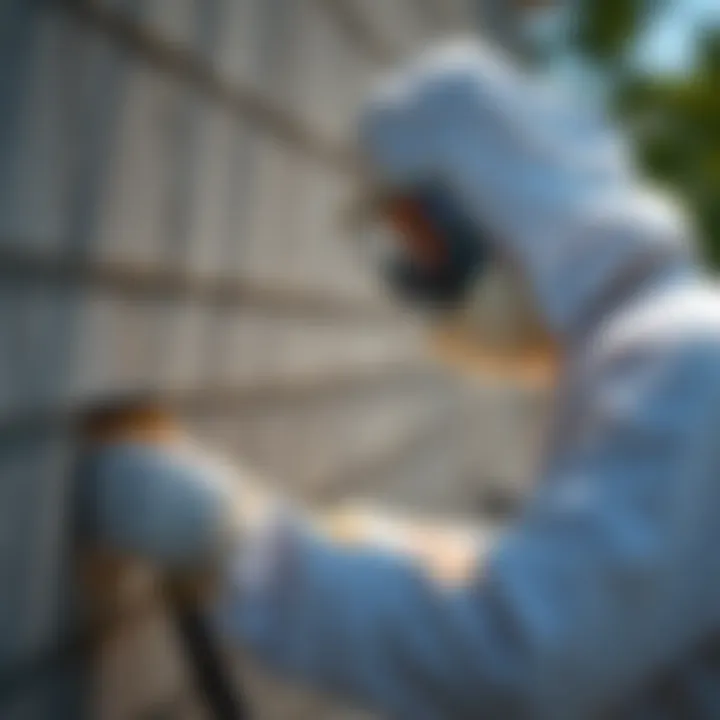
In sum, understanding pest control in urban environments is paramount, intertwining public health, property preservation, and environmental stewardship. Through careful management of pests, residents can coexist more harmoniously with their surroundings.
Local Pest Challenges in Thornton
Pest control is a vital concern in every urban area, and Thornton, Colorado is no exception. Understanding local pest challenges is essential for effective pest management and prevention strategies. By identifying specific pests prevalent in the area, homeowners can take proactive measures to mitigate infestations. Dealing with these pests not only protects property but also ensures the health and well-being of residents. Addressing pest-related issues fosters a safer environment, preserving the quality of life in this vibrant community.
Common Pest Species
Rodents
Rodents, particularly mice and rats, pose significant challenges for homeowners in Thornton. These pests are notorious for their ability to adapt to various environments, making them persistent invaders. A key characteristic of rodents is their rapid reproduction rate, which can lead to overwhelming infestations if not managed promptly. For residents, the presence of rodents can mean more than just property damage; they are known carriers of diseases, which can directly affect human health.
Unique to rodents is their gnawing behavior, which allows them to exploit even the tiniest openings in structures. This adaptability presents challenges in prevention and control, as it requires rigorous inspections and sealing of entry points. Their nocturnal habits also make them harder to detect, often necessitating the use of traps or professional pest control services to effectively manage the problem.
Insects
Insects, ranging from ants to cockroaches, thrive in the warm climate of Thornton. Notably, these pests can invade homes seeking food, shelter, or water, making kitchen areas prime targets. Their ability to reproduce quickly can result in significant populations, posing a challenge to homeowners’ comfort and hygiene.
A primary characteristic of insects is their capacity to transmit diseases, particularly through common household invaders like cockroaches which are known to trigger allergies. An interesting aspect about insects is the sheer variety of species, each with its unique behavior and traits, requiring tailored control measures. What makes insects particularly problematic is their ability to adapt to various pesticides, leading to potential resistance and complicating management efforts.
Termites
Termites are notorious for causing structural damage, making them a significant concern for properties in Thornton. These pests feed on cellulose found in wood, and their colonies can grow exponentially. The capacity of termites to go undetected for long periods makes them a covert threat, only revealing their presence when significant damage has already occurred.
A noteworthy feature of termites is their eusocial behavior, which facilitates cooperative tasks such as foraging and nest building. This can make them extremely efficient at locating sources of wood in homes. Given their potential for destruction, early detection is crucial in managing termite infestations, often requiring specialized knowledge and methods to effectively halt their spread.
Seasonal Pest Activity
Understanding the seasonal fluctuations in pest activity is paramount for homeowners in Thornton. Different pests have specific peaks during the year that correlate with changing weather patterns. For example, as temperatures rise in spring, many insects begin their reproductive cycles, leading to noticeable increases in their populations. Similarly, the fall may see rodents seeking shelter indoors as colder weather sets in.
Keeping a close eye on pest activity throughout the year can help residents implement timely preventative measures. Homeowners can adjust their pest control strategies according to seasonal patterns, ensuring they stay one step ahead in maintaining a pest-free environment. This proactive approach not only helps in immediate management but also establishes longer-term pest prevention.
Identification Techniques
Understanding the techniques for identifying pests is crucial for effective control, particularly in an urban setting like Thornton, CO. Properly recognizing pests can save homeowners time, effort, and money—enabling swift action to manage infestations before they escalate. Effective identification means not only knowing which species you are dealing with but also understanding their behavior, habitat preferences, and the potential health risks they bring. Let's delve into three critical methods of pest identification in more detail.
Visual Inspection
Visually inspecting your home for signs of pests is often the first step toward identifying an issue. This method involves a keen eye and some basic knowledge of what to look for.
- Look for droppings: Different pests leave distinct droppings. For instance, rat droppings are typically larger and can be found in clumps, while mice droppings are smaller and often scattered.
- Check for nests: Rodents often make their homes in hidden spots like behind appliances or in attics. Finding a nest can indicate an active population.
- Examine entry points: Cracks, crevices, and holes around doors, windows, and utility lines can serve as entry points for many pests. Identifying these points can not only help in spotting current infestations but also in preventing future ones.
Visual inspection is a proactive measure that can reveal a lot about what might be lurking undetected before they become a more significant problem.
Using Traps and Baits
Traps and baits offer a more direct method of identifying pest populations, especially when visual signs are not readily available. By strategically placing different types of traps around your home, you can gauge which species are present and in what quantities.
- Snap traps: These are effective for larger pests like mice and rats. The presence of a captured pest can indicate an ongoing infestation.
- Glue boards: While less humane, they can effectively capture smaller insects. Monitoring trap activity helps determine the level of an infestation.
- Bait stations: These are often used for termite control or baiting ants, and their effectiveness in attracting pests can affirm their presence.
Using traps and baits not only aids in pest identification but can also act as a control method in tandem.
Recognizing Signs of Infestation
Every pest leaves behind a signature, making recognizing the signs of infestation invaluable in any control effort. Knowing what to watch for can help in diagnosing a problem quickly.
- Damage: Look for signs of gnawed wires, holes in walls, or wood shavings that can indicate an insect or rodent issue.
- Sounds: Nocturnal pests like rodents can often be heard at night, making scratching or scurrying noises in your walls or attic.
- Odors: A musty smell or a strong, distinct odor can indicate a pest presence—especially for larger infestations.
In essence, being aware of the various signs of infestation empowers homeowners to take charge of their pest management. The earlier pests are identified, the more effective the control strategies can be.
"A stitch in time saves nine," as they say. Identifying pest issues early on is crucial in minimizing damage and expense throughout your home.
Incorporating these identification techniques into your home maintenance routine will bolster your efforts against pests, aligning with a comprehensive pest control strategy.
Prevention Methods
Preventing pest problems starts with understanding that an ounce of prevention is worth a pound of cure. This is especially true in a city like Thornton, Colorado, where diverse pests thrive due to varying climatic conditions. Prevention methods play an essential role in maintaining a pest-free home, offering benefits that transcend mere convenience. Not only do these strategies improve living conditions, but they also promote health and safety for families. Let’s delve into specific elements that form a robust foundation for pest prevention.
Environmental Adjustments
Adjusting your environment can create barriers against pests even before they cross the threshold of your home. The way you arrange your yard and garden could be your first line of defense. Here are some key actions:
- Landscaping wisely: Keeping shrubs and plants at least a foot away from your home helps decrease pest access to the building. This minimizes hiding spots and food sources for insects and rodents.
- Water drainage: Ensure that gutters and downspouts are functioning well. Standing water is a breeding ground for pests like mosquitoes, so proper drainage reduces their populations.
- Natural repellents: Planting pest-repelling herbs, like mint and lavender, can naturally keep some unwanted visitors at bay. It’s not just an environmentally-friendly approach; it also brings fragrance and utility into your garden.
Small changes can yield significant results—keeping your surroundings tidy and strategically ordered can disrupt pest breeding cycles.
Home Maintenance Tips
Day-to-day home maintenance is critical in preventing pests. A well-maintained home doesn't just look good; it also serves as a deterrent for infestations. Here are some practical home maintenance tips to consider:


- Seal cracks and gaps: Check for holes around windows, doors, and foundation. Seal them up tightly with appropriate materials to keep pests out. Even the tiniest crevice can serve as a welcome mat to small vermin.
- Regular inspections: Conducting routine checks in less frequented areas such as attics and basements can catch potential infestations before they escalate. It’s better to be proactive than reactive when dealing with pests.
- Proper temperature control: Keeping your home adequately heated in the winter and cool in the summer can discourage certain pests from making themselves at home in your house.
Maintaining your home isn’t just about aesthetics—it’s a fundamental aspect of responsible pest control.
Waste Management Practices
Efficient waste management can make a world of difference in pest prevention. The way waste is handled directly affects pest attraction. Here are several practices to implement:
- Secure trash bins: Use bins with tightly fitting lids to minimize odors and deter critters. It might seem basic, but a sealed trash can significantly reduces the likelihood of rodent and insect attraction.
- Routine disposal: Regularly emptying trash, not allowing it to pile up, keeps pests from finding a consistent food source.
- Composting carefully: If you compost, be cautious with what goes into your bin. Avoid meat scraps, dairy, and anything that could attract pests. Focus on plant materials, as those are less likely to lure unwanted guests.
"By adopting stricter waste management practices, households can create a less hospitable environment for pests, reducing potential infestations in the long run."
Implementing these prevention strategies is not just about avoiding pests; it also builds a more sustainable home and community. As Thornton homeowners and residents grow more vigilant about their surroundings, they create a ripple effect that benefits everyone. Addressing the pests today with effective prevention methods paves the way for a pest-free tomorrow.
Effective Treatment Options
When dealing with pest control in Thornton, choosing effective treatment options is non-negotiable. The right methods not only tackle existing infestations but also work towards preventing future problems. Homeowners need to understand the landscape of possible solutions to make informed decisions tailored to their specific needs. From chemical solutions to biological alternatives and mechanical methods, each treatment type presents distinct advantages that contribute to a holistic pest management strategy.
Chemical Solutions
Chemical solutions have long been a staple in pest control. These include a variety of pesticides designed to target specific pest species. However, using chemical treatments does come with its own set of intricacies.
It’s essential to consider not just the efficacy of these solutions but also their potential impact on human health and the environment. Many homeowners find the appeal of quick results alluring, yet it’s crucial to be well-informed about the active ingredients used in these products.
- Pros:
- Cons:
- Fast-acting and often effective in severe infestations.
- Wide range of options available targeting various pests.
- Potential toxic effects on pets and children if not handled properly.
- Risks of resistance developing over time if used repetitively.
Homeowners are encouraged to consult with professionals who can provide guidance on the safe and effective use of these chemicals, ensuring that precautions are taken to minimize risks.
Biological Control Methods
Biological control methods offer an eco-friendly alternative to traditional chemical treatments. This approach focuses on using natural predators or pathogens to manage pest populations, making it an increasingly popular choice among environmentally conscious residents. For instance, introducing ladybugs into a garden can help control aphid populations without harming the plants. This method has several benefits that align with sustainable practices.
- Advantages:
- Reduces reliance on chemicals, promoting a healthier environment.
- Can lead to long-term solutions rather than quick fixes.
Some challenges may include the time needed for biological methods to take effect and the necessity of understanding local ecosystems to ensure that introduced species do not become pests themselves.
Physical and Mechanical Solutions
Physical and mechanical solutions bring a hands-on approach to pest control that eliminates pests without chemicals. These options range from simple traps to complex exclusion methods designed to keep pests out in the first place. Simple actions like sealing entry points or using traps can be both effective and safe for households.
- Examples include:
- Sticky traps: Used for monitoring and controlling insect populations.
- Exclusion techniques: Such as screens and barriers to prevent pests from entering homes.
Engaging in these methods can cultivate a proactive mindset towards pest management, emphasizing prevention rather than reaction.
"The best pest control is a well-maintained home that makes it difficult for pests to settle in."
The Role of Pest Control Professionals
Pest control is no simple matter, especially in a community like Thornton, where the interactions between human dwellings and natural habitats can lead to a variety of pest challenges. This is where pest control professionals come into play, wielding their expertise to safeguard homes and health alike. They are the unsung heroes in the ongoing battle against unwelcome pests, playing a crucial role in maintaining the integrity of residential and commercial spaces.
Hiring a qualified pest control service not only brings peace of mind but also ensures that effective, long-lasting strategies are implemented tailored specifically for the local environment. These experts understand the unique pest problems that plague areas around Thornton, from sneaky rodents making their winter hideouts in your garage to stubborn insects that make outdoor living a challenge. With their knowledge, homeowners can avoid the pitfalls of ineffective DIY methods that often do more harm than good.
Choosing a Pest Control Service
When it's time to find a pest control service, knowing how to choose wisely can make all the difference. Not every company is created equal, hence the following factors should be taken into consideration:
- Licensing: Ensure the pest control company holds the proper licenses and certifications required by the state of Colorado. This reflects both quality and professionalism.
- Experience: Look for companies with a proven track record in handling the specific pest issues you face. Longevity in the field often means they’ve dealt with similar problems successfully.
- Reputation: Word of mouth is golden—speak to your neighbors or read online reviews. A company’s reputation can say a lot about the quality of service you can expect.
- Assessment Approach: Ask how a company plans to assess your situation. Are they using a thorough, detailed inspection process? Proper evaluations lead to better-targeted treatments.
Considering these points and asking the right questions can save you headaches down the line. When you choose wisely, you set the stage for a pest-free environment.
What to Expect from an Inspection
Understanding what happens during a professional inspection helps homeowners prepare for the process. Typically, an inspection involves several steps:
- Initial Consultation: The technician will discuss your pest concerns and the problems you've been experiencing. Every bit of information counts.
- Thorough Site Examination: Expect the technician to inspect both the interior and exterior of your property, paying special attention to common pest entry points, nesting areas, and any signs of activity.
- Identification of Potential Risks: Based on their findings, the experts will point out areas that might pose a risk for pest entry or infestation. This involves keen attention to detail.
- Recommendations for Treatment and Prevention: After the inspection, they will provide you with options tailored to your specific situation. This may include pest treatments, preventive measures, or a combination of both.
"A well-performed inspection is the foundational step towards effective pest control. Missing just one detail can lead to pest control measures that fall short."
For those looking to learn more, useful resources can be found at EPA.gov, CDC.gov, and local government websites to better understand pest control protocols.
Sustainable Pest Management Practices
In today’s world, where environmental consciousness is at an all-time peak, sustainable pest management practices are taking center stage. Adopted by both pest control professionals and everyday homeowners, these practices not only target the eradication of pests but also emphasize long-term ecological balance and health. It’s about finding that sweet spot where pest control can be effective without leaving behind a trail of environmental harm.


Sustainable pest management isn't just a trend; it's a necessary shift in how we approach pest solutions for the betterment of our health and environment.
Integrated Pest Management (IPM)
At the heart of sustainable practices lies Integrated Pest Management, or IPM. This strategy goes beyond simply spraying chemicals at the first sign of a pest. Instead, IPM relies on a comprehensive understanding of pest life cycles, behavior, and their natural predators. Homeowners implementing IPM solutions consider several factors:
- Monitoring and Identification: Regularly checking homes for potential pest problems can help catch issues before they escalate. Knowing not just what pests are present, but also when they are most active can drastically reduce the need for aggressive treatments.
- Preventative Measures: Sealing entry points, maintaining a clean garden, and keeping food stored properly all serve as first lines of defense against infestations. These actions can reduce the likelihood of pests making themselves at home, thus minimizing future outbreaks.
- Decision-Making: If a pest problem does arise, IPM encourages choosing interventions based on informed decisions. A gardener, for instance, might opt for beneficial insects like ladybugs instead of chemical pesticides to control aphid populations.
IPM methods not only protect your household but contribute to a healthier community, preserving local ecosystems.
Eco-Friendly Alternatives
With the demand for environmentally-sound options on the rise, eco-friendly alternatives have stepped into the spotlight. This category includes a variety of products and methods designed to control pests while minimizing ecological footprints. Consider these options:
- Botanical Insecticides: Derived from plants, these insecticides utilize natural chemicals to deter pests. For example, neem oil (extracted from the seeds of the neem tree) can effectively handle various pests while being safe for beneficial insects, pets, and humans.
- Diatomaceous Earth: This natural powder is made from tiny fossilized aquatic organisms. When pests come into contact with it, their exoskeletons get damaged, leading to dehydration. It's safe for use around the home and can be sprinkled in areas where pests are known to frequent.
- Essential Oils: Products containing oils like peppermint or tea tree oil can deter unwanted insects due to their potent scents. Not only do they keep household pests at bay, but they also add a pleasant aroma to your space.
By opting for these eco-friendly alternatives, homeowners not only fight pests effectively but also do their part in preserving the ecosystem. When pest control becomes a collaborative effort between nature and humans, it fosters a healthier living space for everyone.
Health and Environmental Impacts
When it comes to pest control, understanding the intersection of health and the environment is crucial. This section is not just an afterthought; it’s a cornerstone of responsible pest management. The effects of pests extend far beyond mere annoyance. From spreading diseases to damaging ecosystems, the implications are significant. Effectively addressing these impacts requires an understanding of the relationship between humans, pests, and the fragile balance of our environment.
Pests and Human Health
Pests are more than just uninvited guests; they pose genuine threats to human health. Rodents, cockroaches, and mosquitoes are known carriers of various diseases that can lead to serious health issues. For example:
- Rodents can transmit hantavirus, which is linked to severe respiratory issues.
- Cockroaches are notorious for triggering asthma attacks, particularly in children.
- Mosquitoes spread vector-borne illnesses such as West Nile virus and Zika.
These health risks make pest management not just about keeping homes tidy but also about safeguarding family health. Regular inspections and employing effective pest control measures can significantly lower these health risks. Not only does it enhance the quality of life at home, but it also alleviates worry about potential illnesses.
The emotional toll on families dealing with infestations is often overlooked. When pests invade personal spaces, the sense of security can be compromised. Families might feel anxious or even unsafe in their own homes, making it essential to take pest control seriously. By addressing infestations systematically, residents can reclaim that peace of mind.
Environmental Considerations
The environment is an intricate web of life, and the impact of pest control practices can reverberate throughout. When evaluating pest management strategies, one needs to consider their environmental footprint. Traditional chemical pest control methods, while effective in the short term, can lead to long-term consequences. Pest control chemicals may contaminate soil and water sources, affecting not just targeted pests but also beneficial organisms like bees and earthworms.
Here are key environmental impacts to consider:
- Ecosystem Balance: Utilizing too many chemicals can disrupt the natural balance, leading to an overpopulation of certain pests while harming their predators.
- Chemical Residue: Pesticide runoff can enter local water reservoirs, harming aquatic life and contaminating drinking water.
- Biodiversity Loss: The indiscriminate use of chemicals targets a wide range of species, which can result in a decline in local biodiversity.
Emphasizing sustainable practices such as Integrated Pest Management (IPM) helps mitigate these risks. IPM reduces reliance on harmful chemicals by incorporating biological control, habitat modification, and mechanical traps. This holistic approach not only protects human health but also preserves our natural environment, making it a paramount aspect of modern pest management.
Regulations and Guidelines
Navigating the intricate world of pest control necessitates a solid understanding of the regulations and guidelines that govern practices in Thornton. Here, it's not just about managing pests; it’s also crucial to align with local laws. This compliance helps ensure safety for both residents and the environment, while minimizing legal repercussions. If you think about it, staying informed about these regulations is like having a map in a maze—it prevents you from going in circles.
Local Regulations in Thornton
In Thornton, regulations surrounding pest control focus on maintaining public health and safety standards. For instance, specific permits may be required for applying certain pesticide treatments, especially in high-density residential areas. Local authorities often outline restrictions on when and how these chemicals can be utilized, aiming to reduce potential exposure risks to people and pets.
It is essential to be aware of the following aspects:
- Licensing: Pest control operators in Thornton must hold valid licenses to legally perform their work. It ensures that they have undergone the necessary training to handle chemicals safely.
- Pesticide Use: Specific products are approved for use in residential environments, taking into account their effectiveness and low toxicity. Homeowners should verify that professionals are using EPA-registered pesticides.
- Notification Requirements: Many areas require pest control services to inform residents of pesticide applications, which contributes to transparency and safety.
Sources like EPA and local government websites provide detailed information on regulations that applicants must comply with. Understanding these elements enables homeowners to make informed decisions and choose reputable pest control professionals.
Best Practices for Compliance
Staying compliant with pest control regulations isn’t a one-time effort; it’s an ongoing responsibility that homeowners must acknowledge. Here are some best practices that can help ensure adherence:
- Research Local Policies: Always stay updated with Thornton’s pest control regulations. Local government sites or community boards often have valuable resources to navigate these regulations easily.
- Choose Certified Professionals: Look for pest control companies that prioritize compliance. Often, these companies will openly share their credentials and methods.
- Document Everything: Maintaining records of pest control services, including products used and application dates, can aid in regulatory compliance and also provide valuable information if issues arise.
"Understanding and adhering to local pest control regulations is not merely a legal obligation; it’s also a commitment to safeguarding your community’s health and well-being."
Following these best practices not only simplifies the process but promotes a healthy living environment, paving the way for effective pest management in Thornton. Remember, a proactive approach today can save headaches tomorrow.
Culmination
In summation, understanding pest control in Thornton, Colorado, is not just about managing irritating pests; it's about safeguarding the home environment and promoting a healthier community. The main elements to consider encompass knowledge of local pest challenges, effective identification techniques, and a strong emphasis on prevention and treatment strategies. Homeowners need to recognize that proactive measures can significantly reduce pest populations. Considerations extend further to sustainable practices and pest control regulations, which ultimately ensure that pest management is not only effective but also environmentally responsible.
The beauty of this approach lies in its benefits—keeping homes free from infestations provides peace of mind. It helps in maintaining property value and, most importantly, it protects the health of families and pets. Moreover, investing time in familiarizing oneself with effective pest management techniques empowers homeowners, equipping them with the necessary tools for effective long-term solutions.
"A stitch in time saves nine." Addressing pest problems at their onset is far more manageable than dealing with infestations that spiral out of control.
Recap of Key Points
To recap, several key aspects have been explored throughout this article:
- Local Pest Challenges: Identified common pests in Thornton, from rodents to insects, alongside their seasonal activities.
- Identification Techniques: Discussed how visual inspections, usage of traps, and recognizing signs of infestations can aid in prompt action.
- Prevention Methods: Covered essential home maintenance and environmental adjustments to ward off pests.
- Treatment Options: Reviewed various solutions, including chemical, biological, and physical methods.
- Role of Professionals: Outlined how pest control services can provide essential insights into effective inspection and treatment practices.
- Sustainable Practices: Emphasized the significance of Integrated Pest Management (IPM) and eco-friendly methods to minimize environmental impacts.
- Health and Environmental Impacts: Discussed how pests interact with human health and the broader environmental context.
- Regulatory Guidelines: Covered local regulations and best practices for compliance in pest control.
Future Directions in Pest Control
Looking ahead, the future of pest control in Thornton will likely evolve based on growing technologies and environmental awareness. Innovations such as smart pest monitoring systems using IoT (Internet of Things) technology could revolutionize how infestations are tracked and prevented. Homeowners may turn to localized solutions such as biocontrol methods that utilize natural predators, minimizing the reliance on traditional chemical sprays.
Another crucial trend involves the rise of community awareness and education. Initiatives aimed at informing residents about pest behaviors and integrated prevention measures will enhance local pest management efficacy. Collaborations between homeowners, pest control experts, and local governments can foster a more informed population, leading to effective community-wide pest solutions.
Furthermore, as sustainability becomes even more critical, expect to see increased demand for green pest management solutions. The fusion of technology with eco-friendly practices might just shape the future of pest control, leading to strategies that are not only effective against pests but also safe for families and pets alike.






